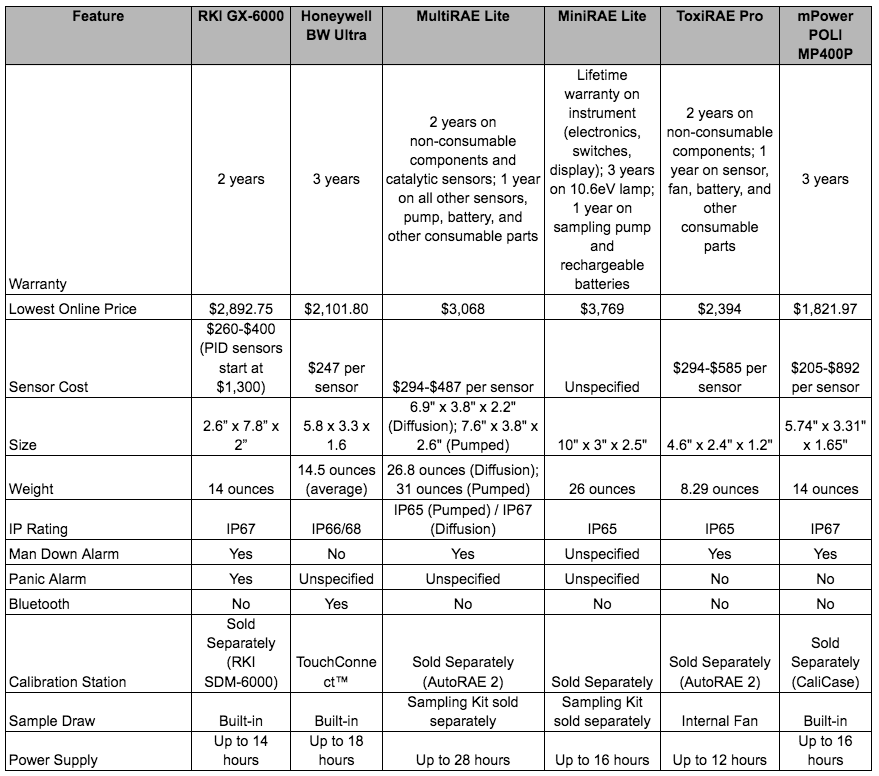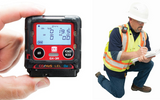Advanced Capabilities of the RKI GX-6000 PID Gas Monitor | PK Safety
There are modern portable gas detectors suitable for a range of applications and instruments capable of handling nearly all gas detection requirements. With a built-in sample pump, six sensor slots for standard confined space, VOC, and toxic gas monitoring, and a suite of advanced features, the RKI-6000 qualifies as one of them.
Below, we delve into these advanced capabilities of this powerful gas monitor to give you a better idea of whether it’s the optimal solution for your specific needs.
Key Features and Benefits of the RKI GX-6000 6 Gas Monitor
The RKI GX-6000 is a handheld, sample-draw unit with a built-in pump (50-foot range) that monitors oxygen levels and combustible, organic, and toxic compounds. In addition to the standard confined space gases (oxygen (O2), carbon monoxide (CO), hydrogen sulfide (H2S), and combustibles LEL (lower explosive limit)), the GX-6000 has two smart channels that will accept sensors for the following:
- Photoionization Detector (PID) sensor for volatile organic compounds (VOCs)
- Infrared (IR) sensor for methane (CH4), hydrocarbon (HC), and carbon dioxide (CO2)
- Electrochemical sensors for ammonia (NH3), chlorine gas (CL2), hydrogen cyanide (HCN), nitrogen dioxide (NO2), and sulfur dioxide (SO2)
The GX-6000 can operate as a single gas PID unit or a multifunctional tool utilizing all six channels. It has three primary operating modes:
- Normal Mode: Used for typical confined space or personal monitoring
- Bar Hole Mode: Designed for investigating underground gas leaks
- Leak Check Mode: Used for locating leaks in valves and piping
With a library of predefined correction factors and reference data for over 600 VOCs and four PID lamp options, GX-6000 users get more accurate readings for specific compounds. The GX-6000 complements its powerful gas detection capabilities with an ergonomic design that fits well in the hands, a compact, glove-friendly button panel for easy, one-hand navigation, a heavy-duty belt-clip for hands-free monitoring, and a large auto-rotating LCD for ease of use.
Detailed Comparison: RKI GX-6000 vs. Leading Competitors in PID Gas Monitoring
To get a better understanding of the RKI GX-6000’s versatility and how it stacks up to other leading multi-gas detectors, here’s an overview of its leading competitors:
- Honeywell BW Ultra: This five-gas detector is specifically designed for sampling and monitoring confined spaces before and after entry. The BW Ultra’s 1-Series sensor boasts fast response, reliable performance, and long life, even in extreme environments. In addition to its large 3.2” screen, the BW Ultra’s Hole Watch Mode provides a graphic next to the readings to show how close the gases are to the point of alarm. Meanwhile, the Honeywell Safety Communicator app enables remote monitoring, making worker safety a team effort.
- MultiRAE Lite: This offering from RAE Systems poses a stiff challenge to the GX-6000’s versatility. With 30 different sensor options and an optional pump, you can configure the MultiRAE Lite to meet almost any gas detection requirement. It has optional wireless capability for remote monitoring and faster incident response. It also provides continuous data logging for up to six months. The MultiRAE Lite’s highly configurable design makes it a future-proof solution for various industries and applications, allowing users to add capabilities as their needs evolve.
- MiniRAE Lite PID Monitor: For more straightforward applications, this simplified version of the MiniRAE 3000 provides a more cost-effective solution for environmental remediation and site surveying. Compared to the MiniRAE 3000, the MiniRAE Lite has a lower parts per million range, lacks data logging capabilities, and has no intrinsic safety certification. However, for many of the environmental consultants and engineers we spoke with, the MiniRAE Lite still brings sufficient capabilities, especially considering the $1,700 price difference.
- ToxiRAE Pro PID: The ToxiRAE Pro PID is one of (if not the) smallest VOC monitors in the market, utilizing RAE Systems’ next-generation PID sensor to quickly and accurately detect over 300 VOCs. It also has an onboard library of 190 correction factors, enabling users to program the instrument to read specified compounds in equivalent units automatically. This information can be accessed wirelessly for enhanced visibility and faster incident response.
- mPower POLI MP400P: This multi-gas detector supports over 30 interchangeable and field-replaceable sensors, including electrochemical sensors for CO, H2S, and NH3 and pellistor sensors for LEL combustibles. Additionally, it offers non-dispersive infrared (NDIR) sensors for LEL, Vol% levels, and CO2. Using combination sensors, the MP400 can simultaneously monitor up to six gases. Overall, the MP400 is a feature-packed gas monitoring solution at a considerably lower price than the others on this list.
Below are other notable factors to consider to help you compare these models:

According to the Occupational Safety and Health Administration, the atmosphere within a confined space must be tested using equipment designed to detect the chemicals that may be present at levels well below the defined exposure limits (OSHA, n.d.). This makes versatile gas detectors like the GX-6000 essential for anyone frequently engaging with confined space work.
Contact our worker safety specialists today for more information about these gas monitors and guidance on the optimal solution for your specific applications.
Technical Specifications: Understanding the RKI GX-6000's Superior Performance
For those eyeing the RKI GX-6000, below are some of its more notable specs:
- Simultaneous Monitoring: With two additional smart channels for PID, IR, or super toxic sensors, the GX-6000 can monitor up to six gases simultaneously.
- PID Sensor Options: The GX-6000 offers four PID options with varying lamp energies: 10.6 eV (two ranges), 10.0 eV, and 11.7 eV lamps. These cover a wide range of VOCs and provide flexibility with distinct sensitivity levels. The GX-6000 complements these with a library of over 600 VOCs for easy target selection.
- Field Replaceable Components: Sensors, batteries, filters, and the pump are all field replaceable, ensuring continuous protection from atmospheric hazards.
The GX-6000’s data logging capabilities can record up to 600 hours of data (set at 10-minute intervals), including gas readings, alarm events, calibration and bump test history, and other relevant parameters, which can be downloaded via the IR communications port.
FAQs: Optimizing the Use of RKI GX-6000 in Various Industrial Applications
- What applications is the RKI GX-6000 suitable for?
The GX-6000’s rugged, reliable, and easy-to-use design makes it ideally suited for a wide range of applications, including sewage treatment plants, utility manholes, tunnels, hazardous waste sites, power stations, petrochemical refineries, mines, paper mills, drilling rigs, and fire fighting stations.
In addition, the GX-6000 is designed to be intrinsically safe for use in potentially explosive environments. According to the International Electrotechnical Commission, “This Type of Protection is applicable to electrical equipment in which the electrical circuits themselves are incapable of causing ignition of a surrounding explosive atmosphere (IEC, n.d.).”
- What are the maintenance requirements for the RKI GX-6000?
Periodic calibration and maintenance are essential for proper operation and accurate readings. Calibration frequency depends on the usage and sensor types. For most applications, the typical calibration frequencies are between one to three months.
Other maintenance requirements include bump testing before each use, periodic sensor and filter replacements, and regular inspections. For optimal performance, follow the manufacturer’s guidelines.
SHOP RKI'S GX-6000 PID Gas Monitor
References:
- International Electrotechnical Commission (n.d.). IEC 60079-11:2023. Retrieved from https://webstore.iec.ch/publication/60654
- Occupational Safety and Health Administration (OSHA) (n.d.) Procedures for Atmospheric Testing
in Confined Spaces. Retrieved from https://www.osha.gov/sites/default/files/publications/atmospheric_test_confined.pdf
Recent Posts
-
Understanding Respirator Replacement Filters
According to the Occupational Health and Safety Administration (OSHA), millions of workers are re …Aug 2nd 2024 -
Explore the RKI GX-3R: The Smallest 4-Gas Monitor | PK Safety
Four-gas monitors have become critical components of workplace safety for industries where exposu …Aug 1st 2024 -
August 12-18 is OSHA’s Safe + Sound Week 2024
Every August, the Occupational Safety and Health Administration (OSHA) spearheads Safe + Sound We …Aug 1st 2024





